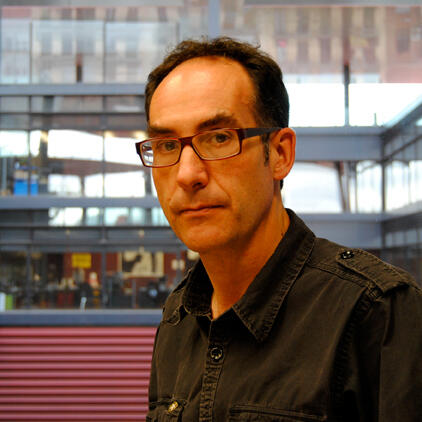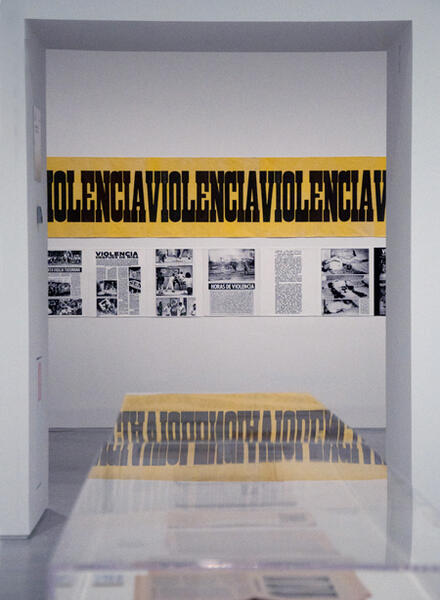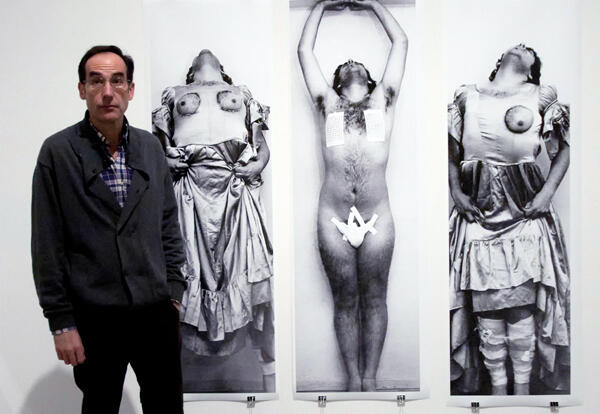Latin American Conceptualism Bursts into the Institutional Arena Bringing New Management Models.
Interview with Jesús Carrillo, head of the Cultural Programs Department at the Museo Nacional Centro de Arte Reina Sofía in Madrid, and researcher and liaison for the Southern Conceptualisms Network.

The possibility of coming into contact with the movements associated to artistic activism of the 1960s and 1970s in Latin America in one of the major European contemporary art centers was, until recently, almost a utopia. At the end of the past year, the Museo Nacional Centro de Arte Reina Sofía presented De la revuelta a la postmodernidad (1962-1982) /From Revolt to Postmodernity (1962-1982) a tour of its holdings representing that period and including a space devoted exclusively to the artistic processes that confronted different Latin American dictatorships with the aim of participating in the transformation of their milieus. Jesús Carrillo has played a leading role in this new proposal together with the Southern Conceptualisms Network, an international platform for work and thought comprised of international researchers whose aim is to participate in the critical processes of these conceptualist practices. Besides being a member of the Network, Carrillo is the liaison between the Reina Sofía Museum and the rest of the researchers, and he has been fundamentally responsible for the adaptation of a fragmented production, detached from the traditional museological discourse, into a structured exhibition and investigation process which would make it possible to understand the importance of these movements in contemporary art and their evolution in Latin America.
What was the origin of the Southern Conceptualisms project and of the involvement of the Reina Sofía Museum in its development?
The collaboration program really began when Manuel Borja-Villel was appointed director of the museum, and it materialized through the creation of the Department of Public Activities. The first projects date from 2008, which was the time when the first collaborative work appeared, although the Network had started operating a little earlier. Both Borja-Villel and I practically witnessed the generation of Southern Conceptualisms, since we were somehow involved in its origination at the Museu d’Art Contemporani in Barcelona (MACBA) at the time when he was its director. The Barcelona museum hosted “Vivid [Radical] Memory,” a seminar organized by Antoni Mercader aimed at implementing a digital database project that would recover the memory of those so-called “peripheral” conceptualisms in terms of their relation to the Anglo-Saxon or Continental European worlds, and which had in common their having developed in the course of dictatorial periods. Resistance was the counter-hegemonic element they shared, and they would form an archive with that which had not been filed or had not been meant to be filed. What happened in the case of “peripheral” conceptualisms was precisely that: they shared the conception that they had not been produced or designed for any kind of museum or archive. That is to say, they were counter-canonical, and they formed part of a movement that opposed the dominant power. MACBA was a natural setting, because it was reexamining conceptual art of those decades. The museum invited artists from Eastern Europe who had been active under Socialist dictatorships, as well as artists from Latin America and Catalonia and the rest of Spain, which was my field of expertise and to which I was invited as a specialist, particularly after having collaborated in the project Desacuerdos (Disagreements). While there was little empathy towards the invitees representing the Eastern countries who intended to occupy the central positions in the culture of post-Soviet states, empathy towards the Latin American artists did indeed exist. They continued to be “in the front”: an institutional stabilization of the situation had not taken place, and in most cases, they were no longer subjected to such severe repression as the one they had undergone; however, they continued to be in a state of emergency due to the scarcity of museums that would narrate the experiences of those years, and besides, they were marked by the policies of “Full Stop” and by the sweetened version aimed at rendering that period more digestible in the present.
And it was at that moment that you realized that your research and your patrimony could be relevant in a new context.
Following the 2002 Kassel Documenta, Latin American conceptual and activist art was suddenly re-discovered and there was a tendency to acquire moral and cultural patrimonies and relocate them to central countries. Those Latin American researchers were aware of the urgent need to generate alternative processes for the institutionalization of that patrimony which would not involve collectors’ ownership or the Neo-Colonial perspective of international museums. A new type of archive needed to be conceived, one that would be open, shared, and susceptible of being permanently activated from the present. Many of these researchers then met personally at the MACBA seminar. This was a key moment of mutual recognition. Something that is very unusual in the ambit of Latin American culture occurred in the Network: the convergence of the will of very different countries. In Latin America there is a very strong national culture, but there is no trans-national tradition, and all of a sudden, these countries began to discover themselves through the gaze that the international art system projected on Latin America, an external front to propose an alternative to. As of that moment, those researchers began to exchange ideas and saw the actual possibility of doing something independently. The following year they met in Sao Paulo, with funding from the Spanish Agency for International Development Cooperation (AECID) and support from the Reina Sofía Museum, as the network they currently make up: Southern Conceptualisms. The MACBA and Antoni Mercader had disappeared from the project as a sign of recognition of that emancipation.
With the collaboration of the Reina Sofía Museum in the activities of the Southern Conceptualisms Network, are we witnessing an episode of rapprochement of positions in the cultural relationships between Spain and Latin America?
Francisco Godoy is posing that possibility in his thesis on Spain’s weak interest in providing an art market and curators for Latin America, a different stand from the one adopted, for example, by the United Kingdom. Until not so long ago, you could find Latin Americanists everywhere, except in Spain. During Franco’s government, there was an attempt to launch a Latin Americanist myth with the aim of re-launching international relations and breaking the isolation, which was endorsed by Juan Perón and other Latin American leaders. In the 1990s, institutions which tried to endow commercial relationships with a certain cultural overtone were created. One of the curious aspects of this process is that, after the first wave in which Ibero-American researchers and students were granted scholarships, and there was a flow of exhibitions in both directions, this neo-colonial dynamics gave rise to reflux processes, and the AECID centers were redefined as focuses of local production. While it is true that the context of re-launching of cultural activities responds to that “imperialism”, the way in which it has developed provides opportunities for Latin American artists and researchers.
Might we then say that the collaboration between the Network and the museum becomes stronger when this panorama is analyzed?
When the Reina Sofía Museum has a new team, it wants to project itself onto the new geopolitical map of culture. It does not want to take a distance from the policies of other museums; rather, it wants to remain faithful to its tradition of making a difference, based on its non-capitalization of other cultures, on mutual recognition. It is at this point that an immediate take-over is established in relation to MACBA’s Southern Conceptualisms and the Reina Sofía Museum. At a moment when United States institutions are becoming consolidated, the Latin American researchers decide to opt for the support of the Reina Sofía Museum as an institution, as a catalytic platform for their projects. The institution keeps its distance: the relationship is not based on commissions or on formal patrimonies, but on mutual loyalty, as in the case of the exhibition Roberto Jacoby. El deseo nace del derrumbe, or of the exhibition of Latin American art of that time which will be scheduled for the current year (2012) in this museum. The funding we contribute makes their research possible, but they do the work: we do not keep the documentary material.
This will evidently lead to an increased interest in the period of Latin American conceptualisms and activism and their production.
We are entering a space of ambiguities, because the greater the visibility we create and the denser the narrative becomes, the greater will be the attraction that these works and artists generate in the global art system. The value of these works will possibly be enhanced and it will consequently be harder to stop the purchase of archives. We might be contributing to popularize this art, but also to propose a new work model: we do not usurp the sovereignty of that material, neither do we appropriate it: rather, we generate a tripartite cooperation between the Network, the artists and ourselves. For example, with the CADA group, the Museum was not trying to buy archives, and we acknowledged the Southern Conceptualisms Network as the genuine decision-maker as far as the future of those archives was concerned, guaranteeing their integrity. Exhibition copies were acquired as a form of economic compensation, and in exchange for this, a foundation which would be the guarantor of the future of that archive and would be in charge of its digitalization and classification, was constituted. It is a work of diplomacy, because any of the parties can break the rules at any time. We keep the results of the investigations and exhibition copies: it is an alternative to more aggressive ways of dealing with Latin American art of those periods which suddenly become attractive.
What appraisal could be done of the mentioned collaboration up to the present? What objectives have been achieved, and which are still pending?
The objectives have been progressively redefined. At the beginning, there was great bureaucratic urgency: we wanted to have everything filed and digitalized in record time. However, there exists a slow process of recognition, for which reason the consolidation of the Network is one of the objectives, irrespective of its subsistence. A moment will come when the Network as such will be dissolved, although hopefully this will take a time. It has become consolidated as an action platform for multiple functions of its members. Entropy itself may dissolve it, for this involves the will of many people and the economic and administrative support of the institutions which, through the Reina Sofía, have made the project possible. We are building an operation, integration and collaboration dynamics among researchers from many countries. The researchers have had the chance to work in Europe and the United States; they have been invited to international forums where our relationship was set as an example. Circumstances may change and the Network may disappear, but reversing the current dynamics will produce results, and these may induce a change in the mentioned dynamics, generating mechanisms of interpretation and interaction and originating pertinent and relevant discourses. What will remain will be a position of one’s own, maturity and recognition.
Since you began with the collaboration between the Reina Sofía Museum and the Southern Conceptualisms Network, have you detected any recognition or interest on the part of Latin American museums concerning this period?
They are a little surprised and perhaps they do not know what position to take. In Latin America, like in many other places, they have their own academic and museological systems, institutions and hierarchies, which are perfectly established. And it is for this reason that the researchers of the Southern Conceptualisms Network cannot expect to be heard in their own countries: their capacity is restrained in their own milieus. Their work would be useless if it were not fruitful in their geographic space for reasons derived from the environment and this would be a reproduction of the center-periphery system. However, little by little they are beginning to obtain recognition: in Chile, the exhibition “Arte de Los Ochenta y Grupo CADA” in 2007 at the National Museum of Fine Arts (MNBA) in Santiago; in Mexico, several members of the Network have already been appointed to determining positions at UNAM’s University Museum of Contemporary Art, or in Colombia, where researchers are re-positioning themselves. The national element is a determining factor. There is no collaboration among institutions, contrary to what occurs in the case of the horizontal interaction that governs the Southern Conceptualisms Network. A transnational method was adopted from the outset: work was based on the local, but synchronous and non-synchronous relationships were established. Nobody works on his/her own, and everyone formulates their conclusions, which is something unprecedented in an institution. The strength of a patrimony resides in the elements outside its own national system.
Profile:
Behind the calm that Jesús Carrillo (Madrid, Spain, 1966) emanates, there is a world of experiences and knowledge that range from the theoretical fields of contemporary art to the teaching methods due to which, after years of experience in higher education centers, he expresses himself in a structured and didactic way. His extensive curriculum renders him one of the most authorized voices on the subject of the cultural management of museums and the new models for institutions: the holder of a BFA in Art History granted by the University of Murcia, Master’s degree in Historical Studies by the Warburg Institute, University of London; and Ph.D. in History, University of Cambridge (King's College), Jesús Carrillo has been a guest researcher at the Huntington Library in Los Angeles, at Brown University in Rhode Island, and at the Consejo Superior de Investigaciones Científicas in Madrid, and he is responsible for the Museo Nacional Centro de Arte Reina Sofía’s cultural activities and programs.
-
 the new proposal for the Reina Sofía Museum’s Collection (Photos: Marta Ruiz)
the new proposal for the Reina Sofía Museum’s Collection (Photos: Marta Ruiz)
“De la revuelta a la posmodernidad (1962-1982)”, la nueva propuesta para la colección del Museo Reina Sofía. (Fotos de Marta Ruiz) -
 “From Revolt to Postmodernity (1962-1982)”, the new proposal for the Reina Sofía Museum’s Collection (Photos: Marta Ruiz)
“From Revolt to Postmodernity (1962-1982)”, the new proposal for the Reina Sofía Museum’s Collection (Photos: Marta Ruiz)
“De la revuelta a la posmodernidad (1962-1982)”, la nueva propuesta para la colección del Museo Reina Sofía. (Fotos de Marta Ruiz) -
 in his office at the Reina Sofía Museum in Madrid
in his office at the Reina Sofía Museum in Madrid
Jesús Carrillo en su despacho en el Museo Reina Sofía (Photo/Foto de Álvaro de Benito)


